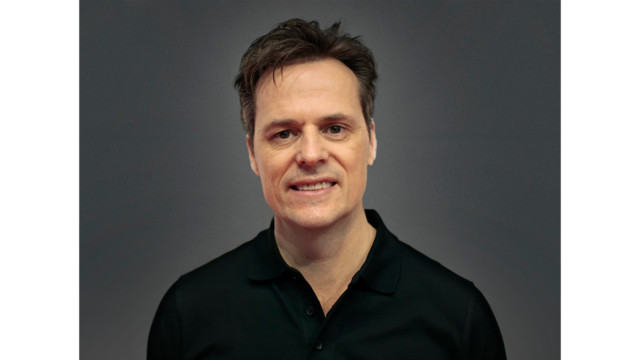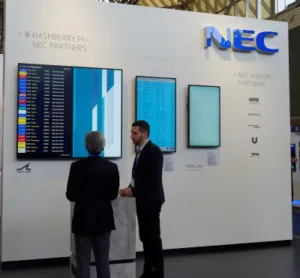 Richard Wilks who heads the global airport business for NEC. Image:NECNEC did not have any new hardware at the show, as we are so soon after ISE, but had a strong team promoting the airport business, where it has a big presence. NEC has, for many years, enjoyed having the widest range of different display technology solutions and remains in a strong position, with LCD, LED and projection. NEC (the part that is not displays) has a strong position in sensors, analytics and telecomms and that helps the overall solutions that NEC can deliver, beyond just the display. It has a global group dedicated to airports and we caught up with Richard Wilks who heads up the global team looking after airports. The strength of the relationship that the firm has was highlighted by the ‘What’s Next?’ meeting that it was hosting at PTE for airport managers.
Richard Wilks who heads the global airport business for NEC. Image:NECNEC did not have any new hardware at the show, as we are so soon after ISE, but had a strong team promoting the airport business, where it has a big presence. NEC has, for many years, enjoyed having the widest range of different display technology solutions and remains in a strong position, with LCD, LED and projection. NEC (the part that is not displays) has a strong position in sensors, analytics and telecomms and that helps the overall solutions that NEC can deliver, beyond just the display. It has a global group dedicated to airports and we caught up with Richard Wilks who heads up the global team looking after airports. The strength of the relationship that the firm has was highlighted by the ‘What’s Next?’ meeting that it was hosting at PTE for airport managers.
Last year, we reported from Cologne on the concept that NEC was promoting the ‘Surfaces’ concept, trying to get away from a simple ‘put a display on a wall’ approach. Airports are evolving very rapidly, with automation and self check-in etc. As a result, although many airports have a very traditional approach, and still look the same as they have done for twenty years or so, the leaders are starting to think more flexibly about how they can use the walls as display surfaces to react to the changes in the way that airports operate. Where this concept is adopted, the company is able to work directly with architects and planners at the very early stages of projects. By the time tenders go out, they are in a very strong position.
NEC has a 48 screen wall at Gatwick, based on LCD technology that is being used for a variety of different messaging. With the change to check-in areas, airlines are looking for revenue opportunities and can use the displays to promote up-sell items such as upgrades, fast track and other services and even pre-orders for services and goods on board. As we reported in our introduction, people should be moving through security and immigration much faster in the future, so airports want to make the most of ‘dwell time’.
Of course, the range of different display solutions helps with this and the most recent addition has been LED. Wilks told us that NEC is starting to see projects coming through now and has a 3.8mm LED display in Gatwick (the wrong terminal for us on the way back, but we know where it is now, so will try to get a good picture!). It has also got a 20mm outdoor display at Frankfurt airport. It expects to get two more projects this year.
One of the big changes this year for NEC is that it now has ‘smart’ options that are below the level of full OPS functionality with the Raspberry Pi option that it has. Seven suppliers of flight information software now support the technology. Wilks explained that the idea for the us of the Pi had come from airport operators that wanted simple, low cost, but upgradable intelligence for displays and had used the first generation Pi to run flight information systems. They have welcomed the development of integrated solutions and love the idea that they can update in the future at very low cost. Simply putting displays into airports is a very expensive business, so upgrading without having to move them is always a great feature.
Wilks told us that a big change in airports is to single control rooms. Historically, different groups such as air traffic control, security, catering, fire etc ran in ‘silos’ with their own systems and little integration. He told us that many airports are run, still, on ‘walkie talkie networks’. The leading airports are now developing single central control rooms where coordinated decision making can be done, enabled by improvements in IT. This is known as Airport Collaborative Decision Making (ACDM). In this kind of application the Hiperwall software that NEC supports, along with fine pitch LEDs or LCDs, can make a great solution. As an example, the central control room at Heathrow has 120 LCD displays to show all aspects of the operation.
However, for some time, although this was attractive to operators, the Hiperwall system could not support redundant servers, so simply could not be considered. However, the latest version of the Hiperwall software can support redundant servers, so that if one fails, there is no break in operation. (Hiperwall Software Now Fault Tolerant) That should really boost acceptance.
As we discussed in the introduction to this report, NEC (not NEC Display Solutions) has analytic software, NeoFace that can support the trend to face recognition as well as other biometric and analytic software. Making sure this all works with Hiperwall and other software is part of the reason that NEC is able to be strong in this market.

